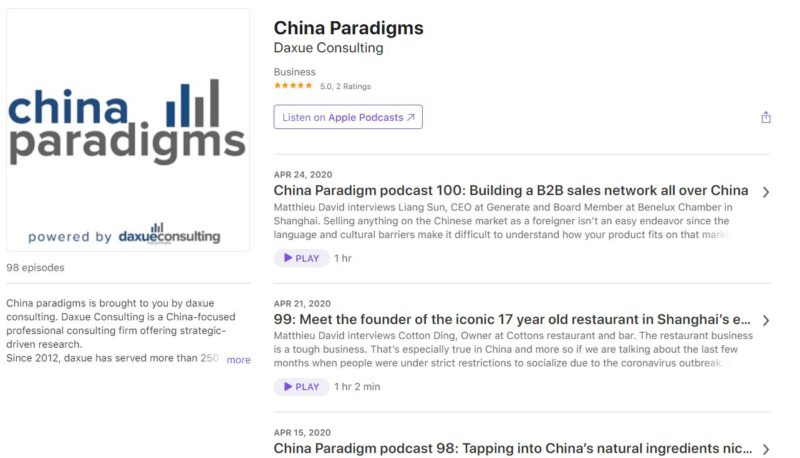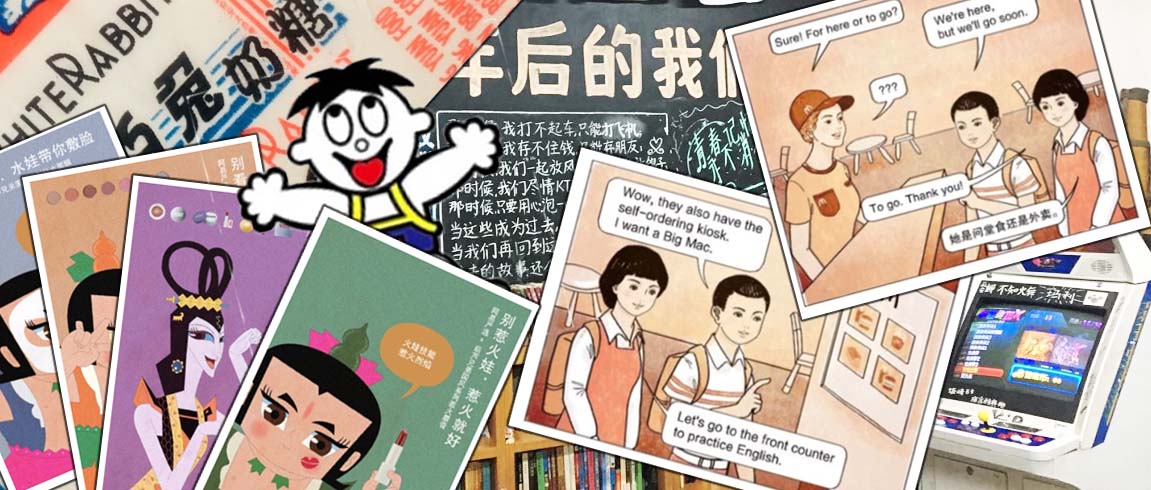Nostalgia marketing aims to capture or recapture the customer’s attention through appealing to cherished memories. Some brands have taken full advantage of nostalgia marketing in China and have resulted in high sales and brand awareness. Chinese millennials grew up during a time when China was relatively closed off to the rest of the world. Hence, the product of their nostalgia is usually domestic brands or domestic cartoons. However, this doesn’t mean nostalgia marketing is limited to domestic brands, foreign brands also take Chinese consumers for a stroll down memory lane through co-branding.
Nostalgia marketing and co-branding in China
Whether it is a cartoon, a candy, or even characters from an textbook, items from childhood and teenage years tend to leave a strong impression on the emotions. A common practice of nostalgia marketing is to partner with a brand that is was dear to the target market during these formative ages.
Wang Wang x Nayuki (旺旺 hot kid x 奈雪の茶 Nai Xue’s Tea): Nostalgia marketing and co-branding in China
Wang Wang, a food maker known for rice crackers and flavored drinks from Taiwan, collaborate with Nayuki (also called Nai Xue’s Tea, a tea drink brand from Guangdong which is rated as one of the top 10 tea drink brands in China) in 2019. The Chinese snack brand aimed to let the target customers recall their happy childhood memories. Therefore, Wang Wang launched its collaborated products on Children’s day in 2019.
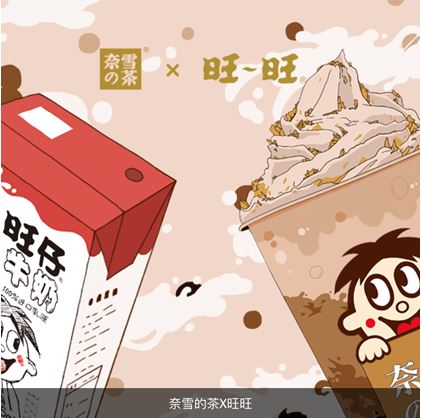
Source: naixuecha.com – Children’s day, come to Nayuki and become the luckiest kid
The resulting products from collaboration combined the characteristics both from Wang Wang and Nayuki, including milk flavored drinks, three different flavor of milk custard. Moreover, customer could redeem Wang Wang logo tea cups with consumption points. This brand collaboration went viral online and was very successful given its limited edition nature, which is why we included it in the 10 most epic marketing campaigns in 2019.
Nostalgia marketing strategies in China has proven to be successful. Moreover, nostalgia marketing often resonates with millennials, who are in the sweet spot for having a relatively materialistically rich childhood while having increasing spending power in adulthood. Hence, brands can leverage optimistic feelings and encourage consumers to make a purchase.
Wahaha x Zhongxuega (哇哈哈 x Chicecream 钟薛高): You are young today
The Wahaha Group Co., Ltd. is the largest beverage producer in China. AD calcium milk (AD钙奶) is one of their products carrying many memories of the post-80s and 90s generation. ‘Zhong Xuegao (Chicecream 钟薛高)’ was the three surnames from Hundred Family Surnames, which is an authentic Chinese ice-cream brand. The brand uses an unique Chinese tile design, supplemented by the top ‘back (回)’ pattern in Chinese, meaning ‘back’ to the original taste.
In March 2020, Wahaha and Zhongxuegao jointly launched AD calcium milk flavor ice cream ‘pre-adulthood ice cream’. The main target customer of the new ice cream are adults who have grown up but “don’t want to grow up”, mainly millennials and Gen Z.
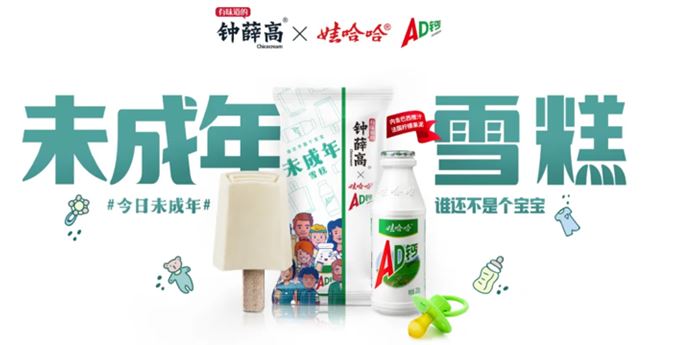
Source: Socialone.com- AD calcium milk: Wahaha x Zhong Xuegao launched “Pre-adulthood ice cream” together.
Wahaha and Zhongxuegao made the flavor of ‘Pre-adulthood ice cream’ in layers, the first taste is rich, delicate with milk flavor. After that, Brazilian orange juice and French lemon puree bring fresh fruit flavor and restore the flavor of AD milk drink.
As Generation Z has become an emerging consumer force, domestic brand Wahaha has been trying to communicate with young people. AD calcium milk, as one of the largest IP of Wahaha, has a highly recognizable taste. As a famous product in the 1990s, AD calcium milk still reaches many generations.
Wahaha uses the marketing theme of ‘don’t want to grow up’ to label young people as ‘babies’ and arouse the resonance of more young people.
The cases of nostalgic marketing in China of these two F&B brands have attracted many consumers. The co-branding nostalgia marketing campaigns in China between brands from different industries also worked.
Nostalgia marketing and co-branding in China between brands from different industries
White Rabbit x Scent Library (大白兔x气味图书馆): Be a little bit childish
White Rabbit is a brand of milk-flavored candies. Originally from Shanghai, the brand has a history of more than 70 years. It cooperated with Scent Library, a domestic fragrance brand which is regarded as ‘National fragrance cleaning and care brand’ in 2019. They launched a variety of skincare and beauty products including perfume, fragrance, lotion and shower gel. All the products from the collaboration incorporate the White Rabbit’s signature milk candy flavor.
Like Wang Wang and Nai Xue’s milk tea, the co-branded products were strategically launched during Children’s Day, which triggered the feeling of nostalgia among millennial consumers. More than 14,000 collaborated products were sold out in the first 10 seconds after the collaboration was launched on Tmall on May 23rd, 2019. In addition, in the two months after rabbit launched its online store, the campaign generated 15 times increase in visit and 1.6 times increase in sales revenue.
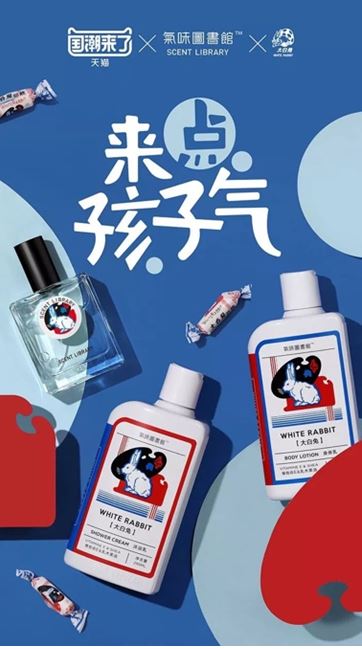
Source: creative.adquan.com – White Rabbit x Scent Library: Be a little childish!
Scent Library is not White Rabbit’s only partner in Chinese nostalgia marketing. The candy brand also launched a limited-edition lip balm with Maxam (美加净) and milk-candy gift box with Agnes.b which did the test for its future brand co-operations. Through the nostalgia marketing campaigns in China, White Rabbit has capitalized on taste, smell, and appearance that has already left an impression on Chinese millennials during childhood. Now that their target market is all grown up, White Rabbit successfully morphed its brand image from an old brand to a classic, fashionable brand.
Wangyi Yanxuan x Hulu brothers (Yeation 网易严选 x Calabash brothers 葫芦兄弟)
Wangyi Yanxuan (Yeation 网易严选) was officially launched in April 2016. Yeation is a NetEase (网易, a Chinese Internet technology company), e-commerce platform focused on furniture, and embraces the brand concept “good life, but not so expensive”. The Chinese name of the brand ‘Wangyi Yanxuan’ also refers to the meaning ‘NetEase helps you select strictly the products in high quality’.
Calabash Brothers (Hulu Brothers) is a Chinese cartoon series produced by Shanghai Animation Film Studio, which was very popular when it was broadcast in 1986-1987.
The cartoon is about a story of seven colored calabash brothers who protect the villagers and their grandpa from a Scorpion spirit and a Snake spirit.
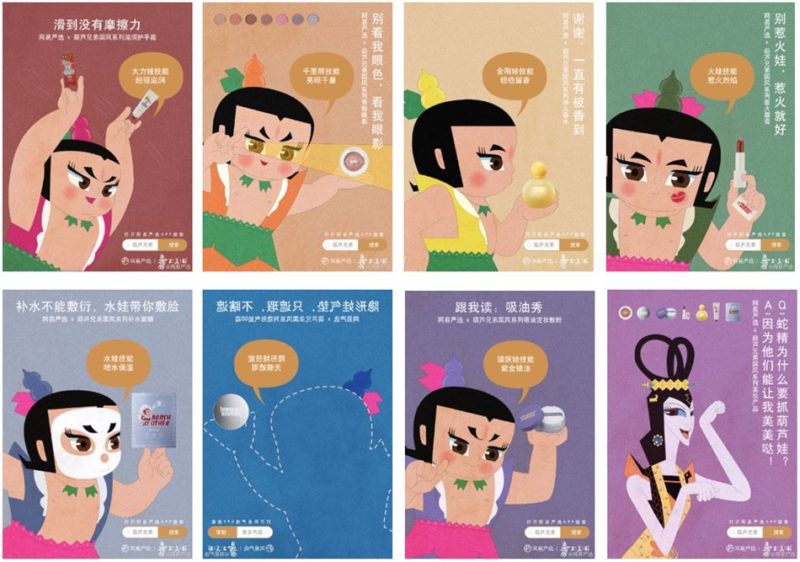
Source: Official Weibo account of Wangyi Yanxuan, co-branding campaign with the Hulu Brothers
NetEase selected seven different functional beauty products according to each super power of the seven brothers.
The brother with great strength corresponds to the hand cream, so no friction will be generated (smooth skin) if the customers use the hand cream. Eye shadow corresponds to the brother with clairvoyant skills, while the brother with water skills corresponds to face mask for moisturizing. The brother with Invisibility skills corresponds to the makeup cushion product for hiding skin imperfections.
NetEase chose to create Calabash Brothers collection in the beauty category. The nostalgia marketing of NetEase instantly caught attention from customers through waking up their childhood memories, generating emotional resonance. Through this co-branding, NetEase not only attracted customer to create topics and contribute to the traffic for the brand, but also attracted fans of Calabash brothers cartoon, which boosted sales conversion.
Foreign brands apply nostalgia marketing campaigns in China
Mcdonald’s x Li Lei and Han Meimei: the classic characters from English textbook in China
Li Lei and Han Meimei were the two main characters in the English textbooks of junior high school published by People’s Education Publishing House from 1990 to 2000. These two characters accompanied a total of 100 million people in their English learning journey. As a result, the classic lines (as follows) have become Chinese millennials’ first impression of English.

Source: Slideserve.com – The characters that taught millions of Chinese how to greet in English
McDonald’s used this memory for reference and leveraged Li Lei and Han Meimei these two characters in the mini comic where they taught students how to order food in English. In the advertisement, Li Lei and Han Meimei went abroad with their classmates. Li Lei struggled to order food at McDonald’s because of his poor English while Han Meimei as a top student, teaches Li Lei how to order food.
The two familiar characters combine Chinese and McDonald’s elements, refining the original memories by blending the old with the new.
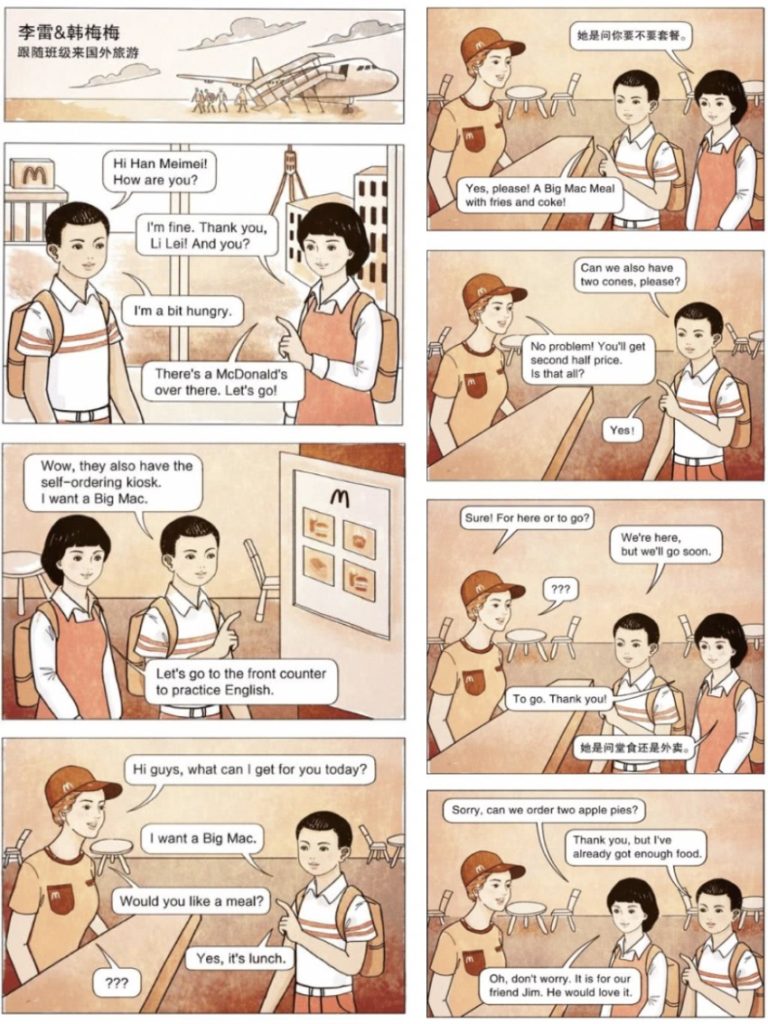
Source: Shangyexinzhi.com – China’s favorite English class characters order food in a McDonald’s ad
In the collaboration with ‘Li Lei and Han Meimei’, McDonald’s chose the topic of ‘Ordering food in English’, which is very consistent with its own brand tone and also a practical and interesting topic. Indeed, as one of the largest fast-food chains in the world, McDonald’s has about 30,000 subbranches around the world and the context of ordering in English in the ads fits the reality of many Chinese consumers traveling overseas.
KFC: Back to the price in 1987
In 1987, KFC opened its first store in China. On the brand’s 30th anniversary in China in 2017, KFC launched “back to the price in 1987” campaign, which triggered a wave of collective nostalgia. During a one-week campaign, the mashed potatoes cost only 0.8 yuan and the Original Recipe chickens cost only 2.5 yuan.
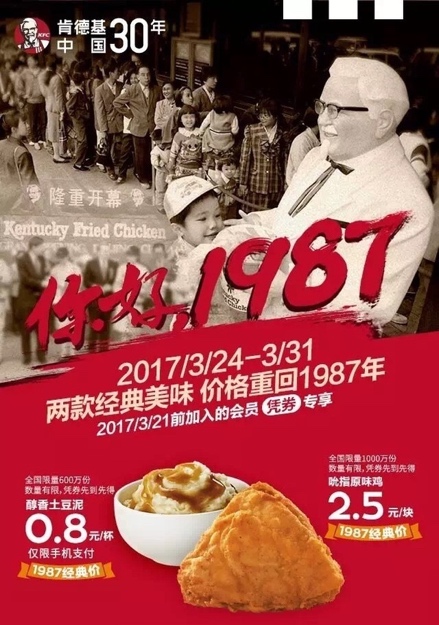
Source: Sohu.com – KFC launched ‘back to the price’ in 1987 campaign
Meanwhile, KFC started the topic of ‘I have the fried chicken, do you have a story to share?’ This marketing campaign became the trendy topic and got the traffic and sales for KFC at the same time.
From consumers’ point of view, the price was obviously favorable. Hence, customers invited their friends into the store and inadvertently ordered a lot of food as a salute to their happy childhood. Consequently, the campaign aroused customers to chat about their past youth on the social platform of KFC.
过去进行食 (The Continuous Past) Restaurant- The Museum of Memory in the ’90s
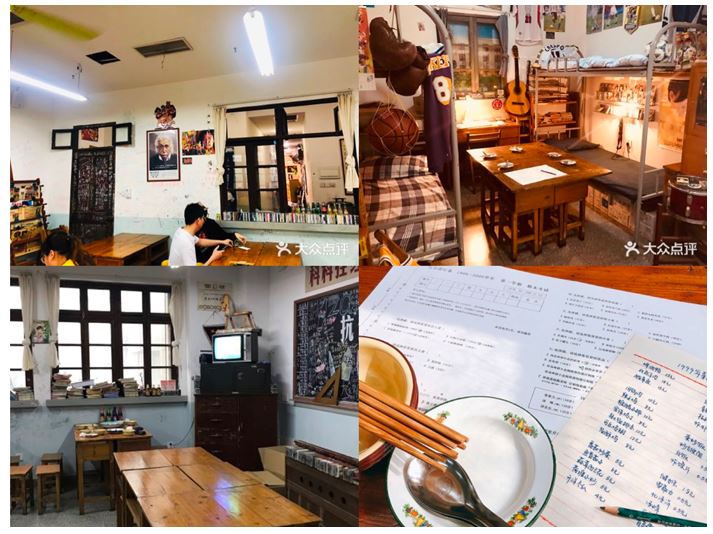
Source: Dazhong Dianping – The atmosphere of the nostalgia-inspired restaurant
The Continuous Past restaurant is a nostalgia restaurant located in Shanghai, China. The restaurant’s layout recreates the classrooms and the boys’ and girls’ dormitories of the 1990s. Complete with musician posters, a blackboard, magazines and books from the 90’s, ustomers raved about the detailed design of the restaurant. Even the tableware and are the same as in old days, with a classic tin ‘lunch box’, and a menu in the form of an exam paper. Many customers have commented that the restaurant took them back to their school days.
The restaurant serves customers’ daily cuisine and drinks and food that were popular in the 90’s. Additionally, the background music of the restaurant is also vintage, resonating with customers’ memory of school and youth time. For a cherry on top, the restaurant even has a school bell that rings every hour.
Tips for nostalgia marketing in China
1. Appeal to the senses
Research shows that senses are closely related to memory, and one familiar scent, sound, or image can cause a myriad of memories and feelings to arise. Therefore, in nostalgia marketing, think of how to appeal to these senses. The restaurant The Continuous Past, uses a school bell sound to cause customers to remember their school days. White Rabbit converts their traditional taste to a similar scent in their new co-branded products. There is even more opportunity to uncover in terms of music and scents that appeal to Chinese consumers.
2. Discover what was popular among the target during their children and teenage years
Between the ages of 12 and 22, dopamine is activated a higher levels. This causes people to have a greater connection to the music, media, and products they were exposed to during that time. For millennials this would be the 80’s and 90’s, a time when China had significantly less cultural influence from the west. If the target market is the silver generation, this would be even truer. Hence, it takes consumer research such as in-depth interviews or focus groups to uncover what your target market truly feels nostalgic for.
3. Co-brand with brands from the past
Fresh, new brands don’t have to miss out on nostalgia marketing. While at the same time, many old, cherished brands can create new opportunity through a second-wind. Co-branding is mutually beneficial in helping both brands expand their consumer base. White Rabbit, has renewed itself through co-branding with a variety of different young and hip brands, effectively turning it into a classic brand.
Author: Qing Zheng
See our full report on nostalgia in China
Listen to 100 China entrepreneur stories on China Paradigms, the China business podcast
Listen to China Paradigm on Apple Podcast
